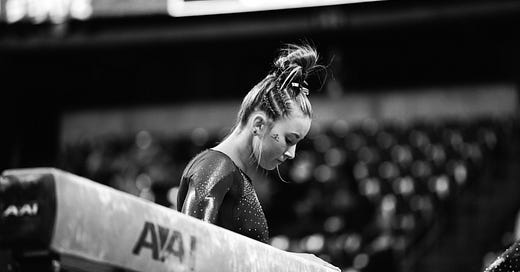You’re probably aware that the Olympics are going on right now—I’ve been tuning in now and then in the evenings to watch the athletes do their thing on this 2024 world stage, despite my aversion to commercials1 and the fact that the primetime broadcast only shows people who win, or are supposed to win2 [or have a human interest/comeback/rise against all odds story]. Despite the pageantry and how they tend to show the same things over and over again, I appreciate the way athletes from all over the world openly support and encourage one another (most of the time), despite their country’s politics or past/present conflicts. There’s a lot wrong in the world (clearly), but it’s heartening to see folks go out, go right to the edge of what’s possible, and engage in something they’ve put so much energy into (and love doing).3
Anyway, my 12 year old and I have been watching a lot of gymnastics and surfing and track & field, which brings with it lots of food for thought. How do you find balance when there’s not a lot of room for error? What helps you recenter after a fall? What’s the best ratio of safety to risk? How do you know when you pace yourself vs. when to go all out? When you do hold on and when do you let go?
I was on the high school gymnastics team from 7-12 grade, and memories of that time in life always return during the Olympics, when the sport takes center stage. I remember the nerves, the long days of practice, the repetition of routine over routine, riding the bus to meets, getting into our uniform leotards before the meets and prancing out as our team was announced, yelling for teammates, falling at just the wrong time, sticking a landing unexpectedly, getting injured, finally being able to practice again, having chalk all over everything all the time.
When gymnastics and track are part of everyday conversation for these 2 weeks, I do my annual test of “can still do a handstand?” and feel slightly more motivated to pick up my pace when running my 2.5 mile loop around the lake.
The following is an excerpt from Collisions of Earth and Sky.
When I was a high school gymnast, the team didn’t have a dedicated practice area. There was a balance beam set up in the empty space at one end of the gymnasium, along with a shorter practice beam, and a few mats stacked on top of each other. Another full-size beam with a crash mat underneath filled the rest of the area. At the other end of the gym was the wrestling mat we used for floor routines4 and two sets of uneven bars. In between the equipment and the basketball court was the netting we set up right after school ended every day—gymnastics season was also boys basketball season, and they had practice at the same time. This netting was supposed to keep us safe.
Before starting apparatus practice, we warmed up by jogging around the perimeter of the basketball court, the whole team in various hues of leotards and spandex shorts with the waists rolled down. No one wore T-shirts, even though some of us wanted to. We stretched, did some more warm-up drills, and broke into groups; one group went to bars on the far side of the gym and the other to the beam. I climbed onto the four-inch surface and tried to concentrate on my handstand instead of the sound of basketballs bouncing.
Instead of the appraising gaze that came from the court now and then. Part of me wished I had a T-shirt on. Part of me wanted to be seen.
In high school and early college, smallness was good. To excel in gymnastics (and long-distance running, which I also did), a small body is an asset. So is strength, which I also wanted, but in those days, I wanted the smallness just as much. Probably more. The uniforms for both sports are tiny and tight. I didn’t want to take up too much space, and I wanted to feel worthy of the space that I did fill. There was something unnerving about being seen, even when I wanted it. Most of the time I didn’t really know what I wanted. I wasn’t sure where my edges were.
How about those questions again: How do you find balance when there’s not a lot of room for error? What helps you recenter after a fall? What’s the best ratio of safety to risk? How do you know when you pace yourself vs. when to go all out? When you do hold on and when do you let go?
What other questions come to mind as you take up the space you need? When you push your edges? Or how about when you allow yourself to stay within them instead of pushing all the time?
Here’s to finding your edges and the best balance (in this season) of comfort/safety and effort/risk.
Have you EVER said to your doctor, “You know, I saw this great medication being advertised on television—I’d like to give it a go.” At least they aren’t showing athletes eating McDonalds anymore. [eye roll]
Also not a fan of the “Winning isn’t for everyone” angle on the Nike ad. What? Gross. Let’s go with “Winning isn’t everything” or “Winning often doesn’t look like you think it should look” or “You are valuable, hard stop” or “Pursuing a win at all costs can be really damaging and we shouldn’t encourage it.”
Here’s to building a world where everyone has the opportunity to engage in the activities they love doing.
We actually tumbled on wresting mats—my HS didn’t get a spring floor (part of why Simone Biles goes so high on her tumbling passes!) until my senior year. And let me tell you, not feeling like you’re tumbling on concrete makes a world of difference.





